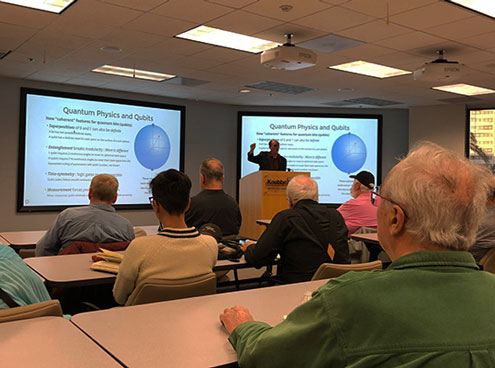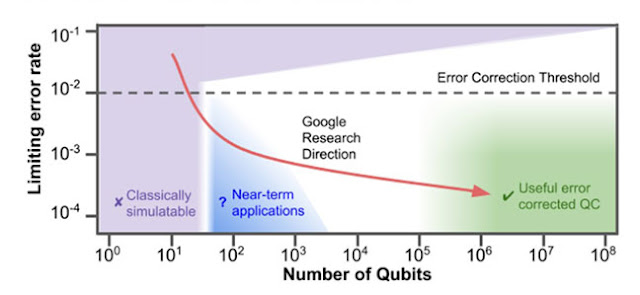Well, yesterday I attended the local Association of Computing Machinery (ACM) meeting in Irvine, CA, where the
presenter, Dr. Justin Dressel, Chapman University, spoke to 150 attendees about “Quantum
Computing – State of Play.” This was an
excellent presentation and since I have been trying to “study” how quantum
mechanics is used to do computing for a couple of years now, I wanted to
summarize some of the takeaway points from my “student” perspective.
If you want to delve more into the computational nature of this topic you can check out at least two textbooks, both of which I use, which are “Quantum Computing – A Gentle Introduction” by Rieffel and Polak and the 2nd book “Quantum Information” by Stephen Barnett.
If you want to delve more into the computational nature of this topic you can check out at least two textbooks, both of which I use, which are “Quantum Computing – A Gentle Introduction” by Rieffel and Polak and the 2nd book “Quantum Information” by Stephen Barnett.
 |
| Dr. Justin Dressel, Chapman U., speaks on Quantum Computing at ACM meeting (Source: Daniel Whelen) |
Dr. Dressel went through an introduction of quantum
mechanics, enough at least to show how the quantum bit relying on superposition
between two states I1> and I0> can be used to store much more information
than can be done with just a classical bit made up of either 1 or 0.
He talked about the nature of quantum logic gates and how by
their very nature are reversible, unlike a typical classic gate like a NAND
gate, which is not reversible. The
quantum bits (Qbits) can be evolved by circuits that perform a unitary
operation, just like in the mathematical description outlined in quantum
mechanics. So the Qbit can associate an
infinite amount of information, represented by a unit vector, pointing somewhere
on the unit Bloch sphere, but once a measurement is made, the information
available then is just a 1 or a 0.
He did not talk much about the measurement problem other
than to say that the original quantum superposition state is lost and cannot be
recovered. To me, I started wondering why
this is not another instance of “information loss” and time asymmetry. The measurement problem then essentially
means that if you try to use time symmetry after a measurement, you will not
recover the original state vector but apparently you will recover the same
statistics? Isn’t this still a situation where information is lost and cannot
be recovered? Any experts that can help work through this
question?
The speaker did not address the issue about initialization
of the Qbits, but we know that one can apply unitary operations to rotate a
given initial condition, 1 or 0, into any arbitrarily chosen position on the Bloch
sphere, so you can set up whatever superposition in the initial state vector
that you want.
He talked about some quantum algorithms like Shor’s algorithm,
which uses a quantum approach to computing Fourier transforms, in linear time,
not exponential time as for classical FFTs.
Then the algorithm can use the transforms as a short cut way of factoring
large prime numbers, which gets everyone excited because it would be a way to
crack the common RSA encryption algorithms.
But, not to worry, as I will shortly go over the speaker’s assessment of
how likely that is going to be.
But before that, he went into some of the quantum
technologies used to implement quantum computing gates and systems right now. He described the two technologies used
currently: (1) Trapped Ions and (2) Superconducting circuits.
The trapped ion approach, headed up the University of
Maryland, has achieved an arrangement of 53 Qbits. Each Qbit is represented by the state of a Ytterbium
atom, with 1’s and 0’s, represented by hyperfine spin transition states, which
can be monitored by the slightly different microwave resonance frequency
associated with each state. The atoms
are maintained in a trapped state by magnetic fields and laser beams, somewhat
similar to what we have seen in laser cooling applications. In addition, the atoms can be manipulated and
moved around in order to interact and become entangled with other atoms. He did not go into how the quantum
entanglement would be used in quantum computing.
The second approach is superconducting circuits operating at
milli-Kelvin temperatures. These circuits
seem to have a speed advantage over the trapped ion approach and can be
manipulated by electric signals and microwaves and do not need to physically
move atoms.
There are many contenders working with superconductors, including
Google, IBM, Rigetti and UC Berkeley.
Google is currently the leader with 72 Qbits in it’s Bristlecone quantum
computer chip. Just because it is a
chip, don’t get excited. Just look at
all the control circuitry needed and the multilevel cooling shelves needed and
the fact that the whole assembly is stored in an evacuated dilution refrigerator.
 |
| Google Bristlecone Quantum Computer Chip Assembly (Source: Google) |
He mentioned that a third type of quantum computer using
just room temperature superconductors is being considered by a lot more research
is still needed. Something like 5-10
years to get to a point to now how this other technology will play out. Ok, if you want to run some of your own programs on a small quantum computer, and you don't want an entire dilution refrigerator taking up the space of one your cars in the garage, you can do it now, by trying out the IBM Quantum Experience at: https://www.research.ibm.com/ibm-q/
If you want some more discussion how superconductor quantum bits works, check out this Wikipedia article: https://en.wikipedia.org/wiki/Superconducting_quantum_computing
If you want some more discussion how superconductor quantum bits works, check out this Wikipedia article: https://en.wikipedia.org/wiki/Superconducting_quantum_computing
Ok, so there is a still a lot of work ahead as the number of
Qbits achievable keeps going up year after year. But what about other practical problems. He mentioned noise as the number one
problem. The noise comes about because
of environmental factors that come about because the operating environment is
not in a total vacuum and still not quite close enough to absolute zero. So, in order to get around this problem which
destroys the quantum superposition, almost like the noise makes a measurement
of the quantum state? Error correction
used to get the error rate down below say about 0.001 to about 10^-20, which is
needed for many applications, such as cracking the RSA encryption
His encryption example started with a higher level key
consisting of 2048 bits. Quantum theory
says you would need twice that number of Qbts to begin, but due to adding
quantum correcting and parity Qbits, the number rises quite quickly and he says
about 10,000 Qbits are needed for every logical Qbit originally called
for. Other factors increase the total
Qbit count for RSA encryption breaking to about 10^9 Qbits. With number of Qbits, the quantum computer has
been estimated to take just 27 hours to break one RSA encryption example. A classical computer, using the best
available factoring routines is expected to take something like 6.4 quadrillion
years. (He listed the Phy Rev A article
which describes all of this but I didn’t copy it down quick enough. Sorry.)
He guessed that within 10-15 years the technology would have
progressed enough to amass this number of Qbits. But what to do until that happens? And why is Google spending a lot of research
money in this field, give that their problem is to search through terabytes and
petabytes of data?
He said that one of the very first applications, just using
a limited number of Qbits will be to solve problems and simulation of small
quantum mechanical systems and molecules.
You need about a hundred Qbits for this.
The tradeoff is almost complete now where the possible quantum computers
of today are just about getting to be faster than the fastest quantum simulation
by classical computers. That is neat,
just use a quantum computer to do quantum mechanics. He also answered the question I had about
Google’s investment. He said that Google
hopes to use quantum computers as teaching tools to help train much larger
systems of machine learning classical computers.
 |
| One indication of Google quantum computing research direction (Source: Google) |
Finally in response to question from the group, he said he had not included anything about D-Wave quantum computing status. I didn't quite get the answer, but it was something to the effect that is some controversy surrounding their announcements about quantum annealing performance. I didn't really get the answer. For those that are curious, quantum annealing refers to a quantum mechanics problem in material science having to do with calculating the minimum value of some objective function involving the states of materials
So that is my summary of the ACM meeting. It was nice to see some faces I recognized: Frank, Larry, Sam, Brian and Dr. Don. Sorry the rest of you couldn't make it. The ACM chapter served good treats and I was able to treat myself to a white chocolate macadamia nut cookie. Yumm! Maybe I'll still be able to see some of you at the UCI Physics Colloquium and the CRIPSR gene editing talk, but for now I have to get back to packing my bags for the trip to visit the VLA.
Until next time,
Resident Astronomer George
There are over 200 postings of similar topics on this blog
If you are interested in things astronomical or in astrophysics and cosmology
Check out this blog at www.palmiaobservatory.com

No comments:
Post a Comment